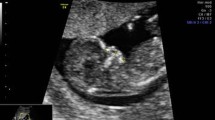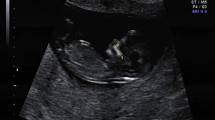Abstract
Purpose
To examine the maxillary length of euploid and aneuploid fetuses in the second and third trimester.
Methods
Retrospective study utilizing stored 2D images of second and third trimester fetal profiles obtained at the University of Tuebingen, Germany. The length of the maxilla was measured as a straight line between the anterior ventral and posterior ventral edges of the maxilla.
Results
The study population consisted of 347 euploid fetuses and 122, 36, 5, 8, and 4 fetuses with trisomy 21, 18, and 13, Turner syndrome, and triploidy. In the euploid and aneuploid group, mean gestational age was 22.3 and 22.7 weeks, respectively. The maxilla length in euploid fetuses was significantly dependent on gestational age and it was significantly shorter in fetuses with trisomy 21, 18, and 13, and triploidy but not in those with Turner syndrome. In 75.4 and 14.8%, and 11 fetuses with trisomy 21, the maxilla was below the mean, the 5th and 1st centile of the euploid population.
Conclusions
In fetuses with trisomy 21, 18, and 13 and triploidy, the maxilla is significantly shorter, but the difference is only settled, so that it is unlikely that the maxilla length will play a role in second and third screening for aneuploidy.






Similar content being viewed by others
References
Sonek JD, Wagner P, Nicolaides KH (2016) Inverted Pyramid of Care. Clin Lab Med. 36(2):305–317
Cicero S (2003) Sonographic markers of fetal aneuploidy?A review. Placenta 24:S88–S98
Agathokleous M, Chaveeva P, Poon LCY, Kosinski P, Nicolaides KH (2013) Meta-analysis of second-trimester markers for trisomy 21. Ultrasound Obstet Gynecol 41(3):247–261
Sonek J, Borenstein M, Downing C, McKenna D, Neiger R, Croom C et al (2007) Frontomaxillary facial angles in screening for trisomy 21 at 14–23 weeks’ gestation. Am J Obstet Gynecol. 197(2):160.e1–160.e5
Yazdi B, Sonek J, Oettling C, Hoopmann M, Abele H, Schaelike M et al (2013) Prefrontal space ratio in second- and third-trimester screening for trisomy 21. Ultrasound Obstet Gynecol 41(3):262–266
Vos FI, De Jong-Pleij EAP, Bakker M, Tromp E, Pajkrt E, Kagan KO et al (2015) Nasal bone length, prenasal thickness, prenasal thickness-to-nasal bone length ratio and prefrontal space ratio in second- and third-trimester fetuses with Down syndrome. Ultrasound Obstet Gynecol 45(2):211–216
Chaveeva P, Agathokleous M, Poon LCY, Markova D, Nicolaides KH (2013) Second-trimester screening for trisomy-21 using prefrontal space ratio. Fetal Diagn Ther 34(1):50–55
De Jong-Pleij EAP, Vos FI, Ribbert LSM, Pistorius LR, Tromp E, Bilardo CM (2011) Prenasal thickness-to-nasal bone length ratio: a strong and simple second- and third-trimester marker for trisomy 21. Ultrasound Obstet Gynecol 39(2):185–190
Suri S, Tompson BD, Atenafu E (2011) Prevalence and patterns of permanent tooth agenesis in Down syndrome and their association with craniofacial morphology. Angle Orthod 81(2):260–269
Lomholt JF, Russell BG, Stoltze K, Kjaer I (2002) Third molar agenesis in Down syndrome. Acta Odontol Scand 60(3):151–154
Shapira J, Chaushu S, Becker A (2000) Prevalence of tooth transposition, third molar agenesis, and maxillary canine impaction in individuals with Down syndrome. Angle Orthod 70(4):290–296
Cicero S, Curcio P, Rembouskos G, Sonek J, Nicolaides KH (2004) Maxillary length at 11–14 weeks of gestation in fetuses with trisomy 21. Ultrasound Obstet Gynecol 24(1):19–22
Kagan KO, Sonek J, Berg X, Berg C, Mallmann M, Abele H et al (2015) Facial markers in second- and third-trimester fetuses with trisomy 18 or 13, triploidy or Turner syndrome. Ultrasound Obstet Gynecol 46(1):60–65
Wagner N, Wagner P, Haen S, Schmidt S, Yerlikaya G, Maden Z et al (2014) Effective management and intrauterine treatment of congenital cytomegalovirus infection: review article and case series. J Matern Fetal Neonatal Med. 27(2):209–214
Hermann NV, Darvann TA, Sundberg K, Kreiborg S, Joergensen C (2015) Maxillary length in 11- to 26-week-old normal fetuses studied by 3D ultrasound. Prenat Diagn 35(6):571–576
Dagklis T, Borenstein M, Peralta CFA, Faro C, Nicolaides KH (2006) Three-dimensional evaluation of mid-facial hypoplasia in fetuses with trisomy 21 at 11 + 0 to 13 + 6 weeks of gestation. Ultrasound Obstet Gynecol 28(3):261–265
Cossellu G, Persico N, D’Ambrosi F, Carbone F, Fabietti I, Boito S et al (2016) Sphenofrontal distance on three-dimensional ultrasound in euploid and trisomy-21 fetuses at 16–24 weeks’ gestation. Ultrasound Obstet Gynecol 48(2):177–180
Maymon R, Levinsohn-Tavor O, Cuckle H, Tovbin Y, Dreazen E, Wiener Y et al (2005) Second trimester ultrasound prenasal thickness combined with nasal bone length: a new method of Down syndrome screening. Prenat Diagn 25(10):906–911
Sonek J, Molina F, Hiett AK, Glover M, McKenna D, Nicolaides KH (2012) Prefrontal space ratio: comparison between trisomy 21 and euploid fetuses in the second trimester. Ultrasound Obstet Gynecol 40(3):293–296
Molina F, Persico N, Borenstein M, Sonek J, Nicolaides KH (2008) Frontomaxillary facial angle in trisomy 21 fetuses at 16–24 weeks of gestation. Ultrasound Obstet Gynecol 31(4):384–387
Gil MM, Quezada MS, Revello R, Akolekar R, Nicolaides KH (2015) Analysis of cell-free DNA in maternal blood in screening for fetal aneuploidies: updated meta-analysis. Ultrasound Obstet Gynecol 45(3):249–266
Kagan KO, Hoopmann M, Singer S, Schaeferhoff K, Dufke A, Mau-Holzmann UA (2016) Discordance between ultrasound and cell free DNA screening for monosomy X. Arch Gynecol Obstet 294(2):219–224
Author information
Authors and Affiliations
Corresponding author
Ethics declarations
Conflict of interest
All authors declare that there is no conflict of interest.
Ethical approval
All procedures performed in studies involving human participants were in accordance with the ethical standards of the institutional and/or national research committee and with the 1964 Helsinki declaration and its later amendments or comparable ethical standards.
This is a retrospective study involving ultrasound images from patients that were seen at the University of Tuebingen, Germany.
The study was approved by the local ethical committee. This is also stated in the Methods section.
Rights and permissions
About this article
Cite this article
Hoopmann, M., Sonek, J., Goldschmid, D. et al. Maxillary length in euploid and aneuploid fetuses. Arch Gynecol Obstet 295, 331–336 (2017). https://doi.org/10.1007/s00404-016-4251-2
Received:
Accepted:
Published:
Issue Date:
DOI: https://doi.org/10.1007/s00404-016-4251-2




